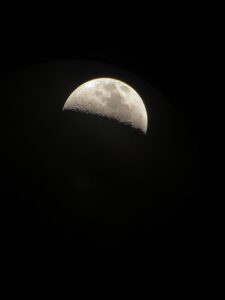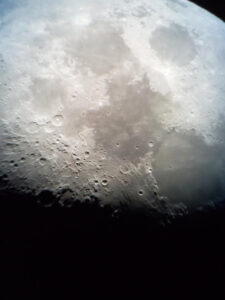The Moon is the biggest, brightest object in the night sky, the most recognizable and familiar — and the most underappreciated. Over years of observing the stars with friends and passersby, I’ve learned that many people think of the Moon as nothing more than a dim version of the Sun: a featureless white disk and convenient source of nighttime illumination. This changes the moment they look at the Moon through an optical instrument of any kind.
People observing the Moon through binoculars or a telescope for the first time are inevitably astonished at what they see. They shout, “Mountains! I didn’t know there were mountains on the Moon!” or “Valleys! Are those valleys?” or “There must be hundreds of craters!” (There are millions, actually.)
Seen this way, the Moon explodes into three dimensions, a rugged, varied terrain of flat plains, sinuous ridges, tall peaks, and sharply defined craters. It is waterless, airless, and nearly colorless. Yet it is also, as Apollo 11 astronaut Buzz Aldrin said moments after his first steps on the lunar surface in 1969, a “magnificent desolation.”

But while the unaided eye may normally perceive none of this, our brains have a wonderful ability to tease out visual detail. If you give your eyes enough time and employ a few easy observation techniques, you’ll be able to see some of these landscape features.
Step outside anytime it’s dark and the Moon is up. (Check online for lunar rise and set times, which change daily, following a 28-day cycle. Many weather apps also note lunar rising and setting times.) Here’s a first observation technique: give your eyes time to adapt to the darkness. The more your pupils dilate, the more light they’ll let in; the more light they let in, the more you can see. Avoid outdoor lighting as much as you can, though this is not as critical as when observing fainter objects. And resist the urge to check your phone, which ruins night vision. When you’re ready, just look up at the Moon.
Don’t expect to see anything at first. Just gaze at it. The Moon rewards the patient. Now the second technique: simply ask yourself, what do I see? If the answer is nothing, that’s OK. Keep looking but don’t struggle to see something. Forget about what you thought you might see. Ask yourself again, what do I actually see? Eventually, you’ll see something. And the longer you look, the more you’ll see. Details will emerge; they’ll be subtle, but certainly you’ll see more than a featureless disk.
One of the first things you’ll probably notice are the maria. These are large dark patches on the surface, which, from our vantage 200,000 miles away, look a bit like seas. They’re not. Until the invention of the telescope in 1608 and Galileo’s first optically aided lunar observations, many astronomers wondered if these vast dark areas were oceans. They called them mare (plural maria), Latin for oceans. They’re actually flat plains of cooled lava that has filled giant craters. The impact that formed each of these enormous craters punched a hole through the Moon’s crust, which allowed molten rock (lava) from the interior to well up and fill the crater. They’re dark because this rock is of a different, less reflective chemical composition than other surface rocks.

Keep looking and you’ll also find some craters. Scan along the Moon’s equator (the imaginary line that divides the northern and southern hemispheres) and look for a tight, bright circle within a slightly less bright patch within a dark mare. That’s the crater Copernicus, named after the 16th-century astronomer who first hypothesized a Sun-centered universe. It’s about 57 miles across, two miles deep, and formed about 800 million years ago when a large meteor struck the Moon. The slightly less bright material surrounding the crater is ejecta from the impact: all the stuff blown upwards when the meteor hit, which then fell back to the surface.
Now direct your attention a little south of the equator. You may notice a wide, bright, rough area that looks like it might be mountainous. You’re right about that: these are the southern highlands, a rugged terrain of mountains, ridges, and many overlapping craters. We’re looking for one large crater in particular: Tycho, named after Tycho Brahe, another 16th-century astronomer.
Tycho is a very young crater (only about 100 million years old) set against the bright highlands, making it a little difficult to see at first. But its prominent ray system sets it apart. Look for a bright white circle, about the same size as Copernicus, with conspicuous rays, or lines of white material, extending out radially from the rim of the crater. These rays are ejecta material. Once your eye catches hold of them, you might be able to follow the lines of ejecta for hundreds of miles out into the maria north of Tycho.
If you have trouble finding Tycho or Copernicus, it may be because they’re not visible when you observe. The illuminated part of the lunar surface changes from night to night, either increasing (waxing) or decreasing (waning) as the Moon orbits Earth. Depending on where you are in the lunar cycle, the craters may emerge into the light in a night or two, or you may have to wait a couple of weeks.
The Moon’s changing phases can seem confusing and esoteric at first. But there’s an underlying logic to the lunar cycle. Challenging yourself to observe its visible features is a good way to get to know our satellite a little better. Clear skies!



